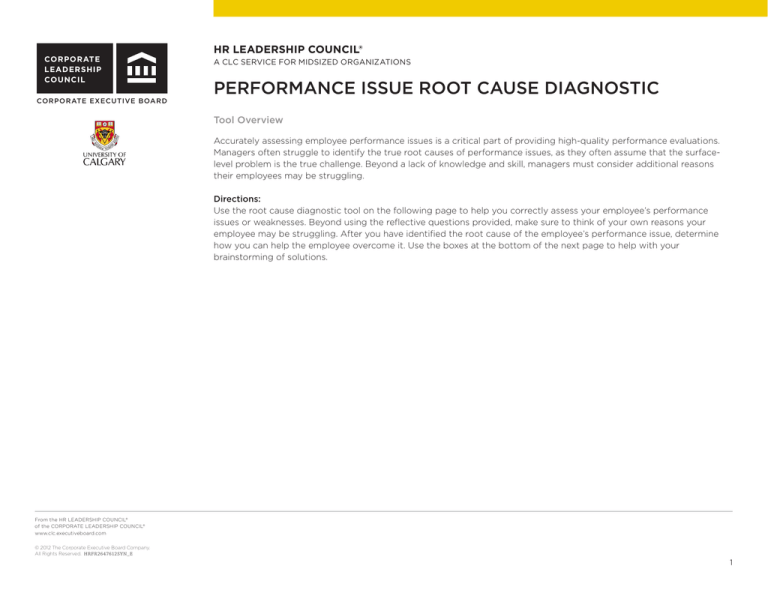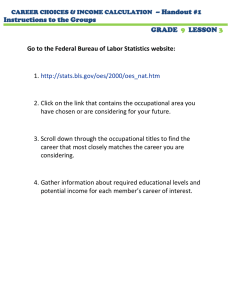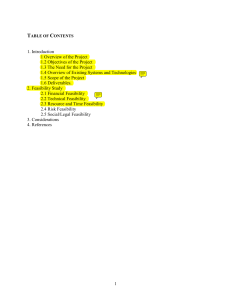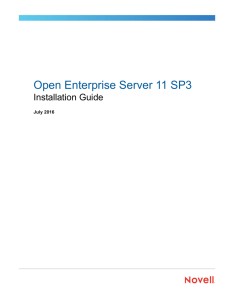
CORPORATE
LEADERSHIP
COUNCIL
CORPORATE EXECUTIVE BOARD
HR LEADERSHIP COUNCIL®
A CLC SERVICE FOR MIDSIZED ORGANIZATIONS
PERFORMANCE ISSUE ROOT CAUSE DIAGNOSTIC
Tool Overview
Accurately assessing employee performance issues is a critical part of providing high-quality performance evaluations.
Managers often struggle to identify the true root causes of performance issues, as they often assume that the surfacelevel problem is the true challenge. Beyond a lack of knowledge and skill, managers must consider additional reasons
their employees may be struggling.
Directions:
Use the root cause diagnostic tool on the following page to help you correctly assess your employee’s performance
issues or weaknesses. Beyond using the reflective questions provided, make sure to think of your own reasons your
employee may be struggling. After you have identified the root cause of the employee’s performance issue, determine
how you can help the employee overcome it. Use the boxes at the bottom of the next page to help with your
brainstorming of solutions.
From the HR LEADERSHIP COUNCIL®
of the CORPORATE LEADERSHIP COUNCIL®
www.clc.executiveboard.com
© 2012 The Corporate Executive Board Company.
All Rights Reserved. HRFR2647612SYN_E
1
CORPORATE
LEADERSHIP
COUNCIL
CORPORATE EXECUTIVE BOARD
HR LEADERSHIP COUNCIL®
A CLC SERVICE FOR MIDSIZED ORGANIZATIONS
PERFORMANCE ISSUE ROOT CAUSE DIAGNOSTIC
Questions for Managers to Assess Underlying Root Causes of Employee Performance Issues
Employee Performance Issue:
MOTIVATION
ENVIRONMENT
Does the employee want to complete
the task?
Is the job properly scoped and
relevant to current business
demands?
Does the employee feel that his/her
work is valued?
re internal processes clear and
A
efficient?
Is the employee fully engaged?
■■
■■
■■
ave you clearly explained how the
H
employee’s responsibilities connect
to the organization’s strategy?
oes the employee experience
D
conflicting priorities?
Does the employee have the
ambition to be successful?
Are there clear reporting lines within
the organization?
Does the employee feel challenged?
re there personal issues affecting
A
the employee?
Does the organization’s infrastructure
allow the employee to fulfill his/her
responsibilities?
oes the employee clash with other
D
team members’ personalities?
oes the employee have access to
D
the resources he/she needs?
Are there bureaucratic inhibitors?
Suggest support resources if the
employee is dealing with a personal
issue.
■■
■■
Escalate organizational issues beyond
your control to more senior leaders.
Consider if adjustments to the
employee’s responsibilities are
necessary as a result of recent
organizational changes.
SKILL
Have you clearly explained the
expectations to the employee?
Does the employee understand how
to complete the task?
Does the employee understand his/
her role and responsibilities?
Has the employee received all
necessary training?
Does the employee have the
information he/she needs?
Has the employee completed a
similar task in the past?
Do you and the employee have a
mutual understanding of his/her
strengths and weaknesses?
Can the employee complete the task
to the expected performance level?
Does the employee understand how
to use the necessary technology?
oes the employee understand when
D
to use available technology?
Does the employee have poor time
management skills?
oes the employee know what to
D
prioritize?
Do the employee’s competencies
align with the job responsibilities?
o you provide the employee with
D
high-quality formal and informal
feedback on a regular basis?
re senior leaders giving consistent
A
messages across the organization?
Clarify how the employee directly
impacts the organization’s success.
Understand the employee’s career
aspirations and identify opportunities
to support them.
KNOWLEDGE
Does the employee receive adequate
on-the-job development?
■■
Clearly explain the employee’s role
and responsibilities.
■■
Provide the employee with additional
training and development on key
information.
Is the organization a good cultural fit
for the employee?
■■
Consider alternative positions, within
or outside of the organization.
■■
Provide the employee with additional
training and development to build
lacking capabilities.
From the HR LEADERSHIP COUNCIL®
of the CORPORATE LEADERSHIP COUNCIL®
www.clc.executiveboard.com
© 2012 The Corporate Executive Board Company.
All Rights Reserved. HRFR2647612SYN_E
2







